If we look at the opposing forces (like charges repel, unlike charges attract) we see only two vectors, which are the sum of the two opposing or attracting forces.
These are, of course, composed of differing forces. Again. if we consider only mass and velocity, we can say that the linear momentum (of a system of particles) can be defined as the product of the total mass, (m), of the system times the velocity, (v/cm), of the centre of mass.
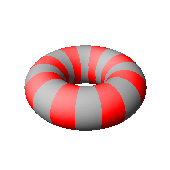
Turning a punctured torus inside-out
What happens to a system like the one above, in which both systems, (states) are closed, but there is a change in the state. For example, imagine that the red and grey lines represent electrons, or particles, which are orbiting around a centre of mass. As the relative radii of the two circles composing the torus shape alter with respect to each other, their direction of travel is changing from around the centre of mass, (and each travelling a different circumference distance), to travelling parallel to and away from the new centre of mass. This path, of course, may not be possible in the real world.
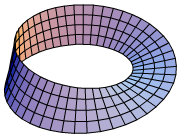
In geometry, a torus (pl. tori) is a surface of revolution generated by revolving a circle in three dimensional space about an axis coplanar with the circle.
In topology, a ring torus is homeomorphic to the Cartesian product of two circles: S1 × S1,
and the latter is taken to be the definition in that context. It is a
compact 2-manifold of genus 1. The ring torus is one way to embed this
space into Euclidean space, but another way to do this is the Cartesian
product of the embedding of S1 in the plane. This produces a geometric object called the Clifford torus, surface in 4-space.
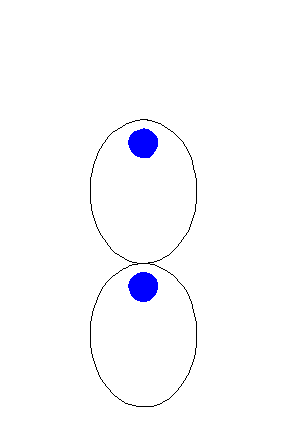
In mathematics, four-dimensional space ("4D") is an abstract concept derived by generalizing the rules of three-dimensional space. It has been studied by mathematicians and philosophers for almost three hundred years, both for its own interest and for the insights it offered into mathematics and related fields.

Magnetism is a property of materials that respond at an atomic or subatomic level to an applied magnetic field. Ferromagnetism is the strongest and most familiar type of magnetism.
It is responsible for the behavior of permanent magnets, which produce their own persistent magnetic fields, as well as the materials that are attracted to them. However, all materials are influenced to a greater or lesser degree by the presence of a magnetic field. Some are attracted to a magnetic field (paramagnetism); others are repulsed by a magnetic field (diamagnetism); others have a much more complex relationship with an applied magnetic field (spin glass behavior and antiferromagnetism). Substances that are negligibly affected by magnetic fields are known as non-magnetic substances. They include copper, aluminium, gases, and plastic.
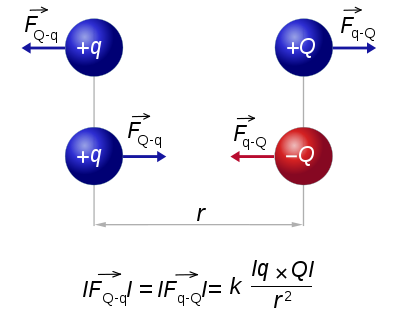
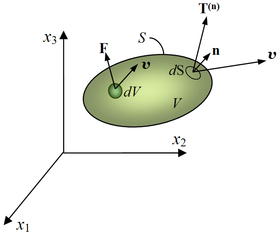
The linear momentum of a system of particles can also be defined as the product of the total mass, m, of the system times the velocity, vcm, of the center of mass.
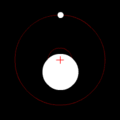
Two bodies orbiting a barycenter internal to one body
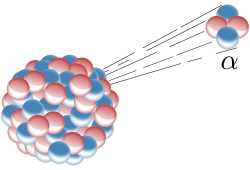
An alpha particle is a helium nucleus, with two protons and two neutrons, but no electrons.It is created by the process of nuclear fission. It has integredy, in that it remains as an alpha particle, and does not disintergraate further, but strips electrons from other molecules, (causing burns to human flesh and skin).
In nuclear physics and nuclear chemistry, nuclear fission is a nuclear reaction in which the nucleus of an atom splits into smaller parts (lighter nuclei), often producing free neutrons and photons (in the form of gamma rays), and releasing a tremendous amount of energy.
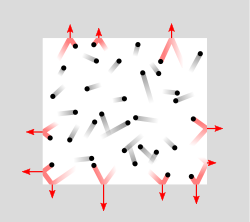
What is an electron made of? It is probably composed of photons, but there may be intermediate steps on the way. An electron has a mass of only 1/1836th of a proton.
If you think of it as a bag of something, like a water droplet, in which the surface tension keeps its structure intact you are close. Electrons do not fly about freely, but flow along conductors, and can discharge through space as lightning from the charged water droplets in clouds, or when a voltage has sufficient magnitude for the electricity (electrons) to jump to a conductor.
The electron (symbol: e−
) is a subatomic particle with a negative elementary electric charge. It has no known components or substructure; in other words, it is generally thought to be an elementary particle.[2] An electron has a mass that is approximately 1/1836 that of the proton.[8] The intrinsic angular momentum (spin) of the electron is a half-integer value in units of ħ, which means that it is a fermion.

Torus
Intuitively speaking, this means that a closed path that circles the torus' "hole" (say, a circle that traces out a particular latitude) and then circles the torus' "body" (say, a circle that traces out a particular longitude) can be deformed to a path that circles the body and then the hole. So, strictly 'latitudinal' and strictly 'longitudinal' paths commute. This might be imagined as two shoelaces passing through each other, then unwinding, then rewinding.
If a torus is punctured and turned inside out then another torus results, with lines of latitude and longitude interchanged.
The Sun is a magnetically active star. It supports a strong, changing magnetic field that varies year-to-year and reverses direction about every eleven years around solar maximum.[63] The Sun's magnetic field leads to many effects that are collectively called solar activity, including sunspots on the surface of the Sun, solar flares, and variations in solar wind that carry material through the Solar System.[64] Effects of solar activity on Earth include auroras at moderate to high latitudes, and the disruption of radio communications and electric power. Solar activity is thought to have played a large role in the formation and evolution of the Solar System. Solar activity changes the structure of Earth's outer atmosphere.[65]
All matter in the Sun is in the form of gas and plasma because of its high temperatures. This makes it possible for the Sun to rotate faster at its equator (about 25 days) than it does at higher latitudes (about 35 days near its poles). The differential rotation of the Sun's latitudes causes its magnetic field lines to become twisted together over time, causing magnetic field loops to erupt from the Sun's surface and trigger the formation of the Sun's dramatic sunspots and solar prominences (see magnetic reconnection). This twisting action creates the solar dynamo and an 11-year solar cycle of magnetic activity as the Sun's magnetic field reverses itself about every 11 years.[66][67]
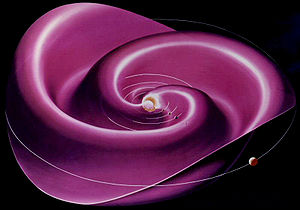
The heliospheric current sheet extends to the outer reaches of the Solar System, and results from the influence of the Sun's rotating magnetic field on the plasma in the interplanetary medium.[62]
The heliospheric current sheet (HCS) is the surface within the Solar System where the polarity of the Sun's magnetic field changes from north to south. This field extends throughout the Sun's equatorial plane in the heliosphere.[1][2] The shape of the current sheet results from the influence of the Sun's rotating magnetic field on the plasma in the interplanetary medium (Solar Wind).[3] A small electrical current flows within the sheet, about 10−10 A/m². The thickness of the current sheet is about 10,000 km.
The underlying magnetic field is called the interplanetary magnetic field, and the resulting electric current forms part of the heliospheric current circuit.[4] The heliospheric current sheet is also sometimes called the interplanetary current sheetThe solar magnetic field extends well beyond the Sun itself. The magnetized solar wind plasma carries Sun's magnetic field into the space forming what is called the interplanetary magnetic field.[59] Since the plasma can only move along the magnetic field lines, the interplanetary magnetic field is initially stretched radially away from the Sun. Because the fields above and below the solar equator have different polarities pointing towards and away from the Sun, there exists a thin current layer in the solar equatorial plane, which is called the heliospheric current sheet.[59] At the large distances the rotation of the Sun twists the magnetic field and the current sheet into the Archimedean spiral like structure called the Parker spiral.[59] The interplanetary magnetic field is much stronger than the dipole component of the solar magnetic field. The Sun's 50–400 μT (in the photosphere) magnetic dipole field reduces with the cube of the distance to about 0.1 nT at the distance of the Earth. However, according to spacecraft observations the interplanetary field at the Earth's location is about 100 times greater at around 5 nT.[68]
The difficulty of controlling a nuclear reactor, is stopping the emission of excess neutrons. This is done by inserting control rods to absorb them before the nuclear chain reaction gets out of control.
A control rod is a rod made of chemical elements capable of absorbing many neutrons without fissioning themselves. They are used in nuclear reactors to control the rate of fission of uranium and plutonium.
Atomic pile
Chicago Pile-1 (CP-1) was the world's first man-made nuclear reactor.[4] CP-1 was built on a rackets court, under the abandoned west stands of the original Alonzo Stagg Field stadium, at the University of Chicago. The first self-sustaining nuclear chain reaction was initiated in CP-1 on December 2, 1942.
The reactor was a pile of uranium and graphite blocks, assembled under the supervision of the renowned physicist Enrico Fermi, in collaboration with Leó Szilárd, discoverer of the chain reaction. It contained a critical mass of fissile material, together with control rods, and was built as a part of the Manhattan Project by the University of Chicago Metallurgical Laboratory. The shape of the pile was intended to be roughly spherical, but as work proceeded Fermi calculated that critical mass could be achieved without finishing the entire pile as planned.[5]